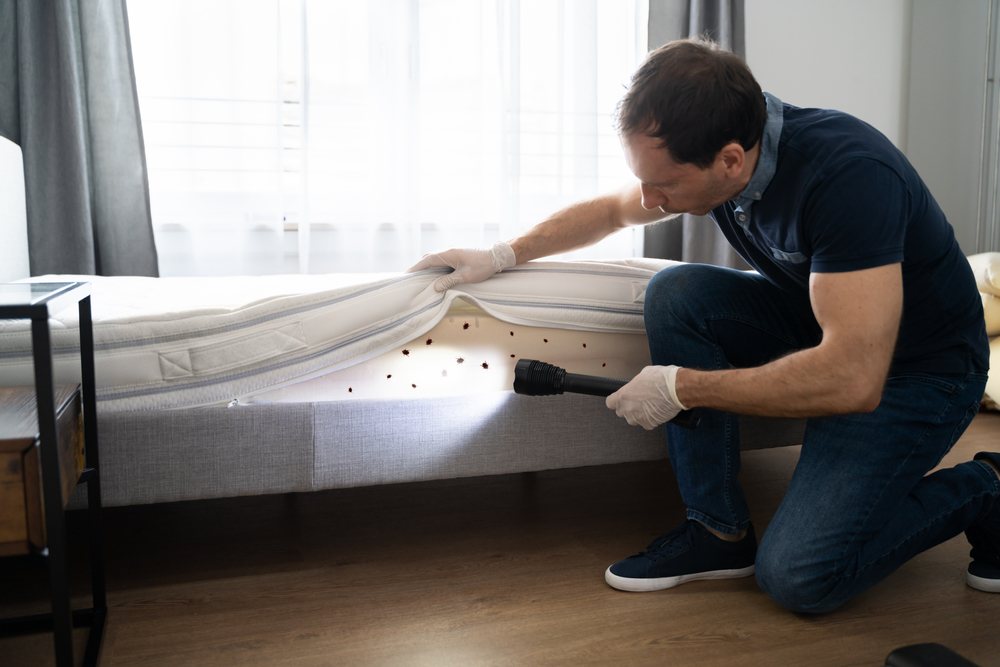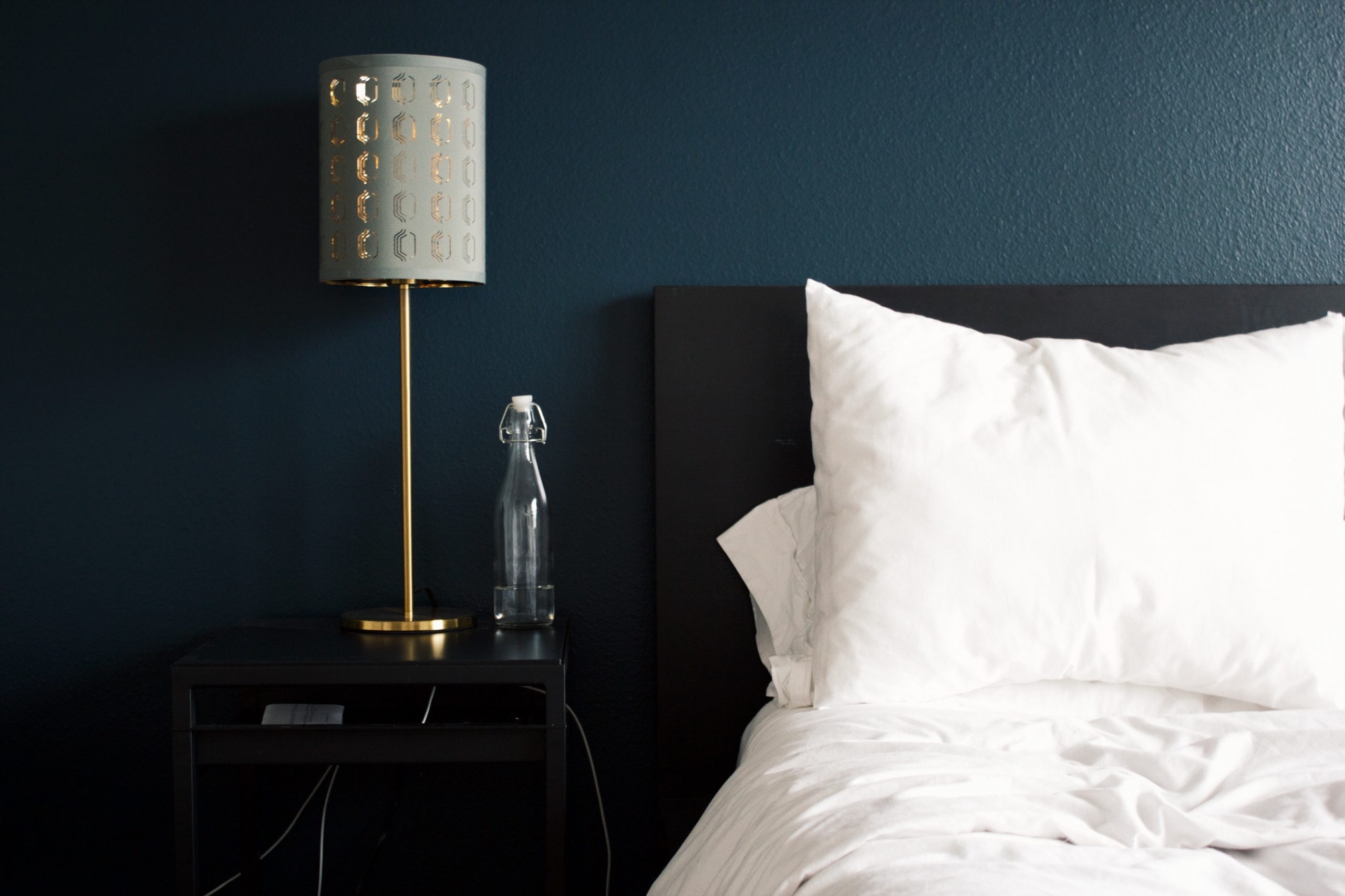Bed bugs are called “bed” bugs for a reason.
As they’re often found on your mattress and box spring.
This makes it easy for bed bugs to feed on your blood while you’re asleep.
Unfortunately removing these creatures from your bed isn’t easy because of their ability to hide.
Whether it be on your…
- Mattress.
- Comforter.
- Pillow or Pillowcase.
- Bed Frame.
- Metal Springs etc.
These creatures are not picky.
In order to reduce the impact of an existing infestation, customers resort to buying special mattress covers, with the idea being….
That you trap the bed bugs inside.
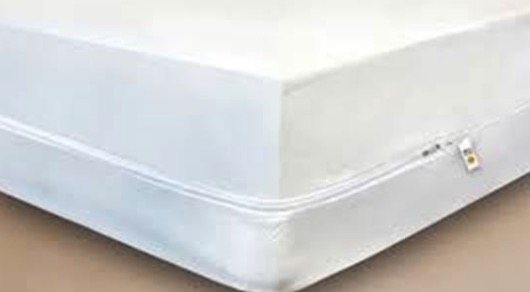
The question is….
Do They Really Work?
If so what kind of cover do I need to buy?
If I have a mattress cover do I also need to use other methods to treat an infestation?
In this article, we will answer exactly these questions.
And go through the steps required to prevent or eradicate a bed bug infestation.
Page Contents:
Mattress Covers vs. Mattress Encasements
If you’re thinking about buying something for your mattress to mitigate an existing infestation in your home or apartment…
You should understand the difference between a mattress encasement, and a mattress cover.
(Note: If you’re a renter with a bed bug infestation you may be eligible for financial compensation)
Mattress Encasement:
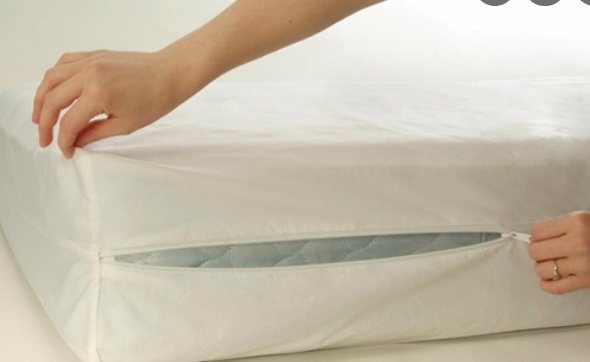
This is a material that zips closed around the entirety of the mattress.
The idea of the encasement is to completely envelop the mattress and box spring, trapping bed bugs inside.
Mattress Cover:
This material generally only covers the top of the bed.
These typically offer limited protection in terms of physical coverage and may be of a thinner, less durable material.
If you’re using an older, non-specialized mattress cover, you might not be protected from bed bugs getting through.
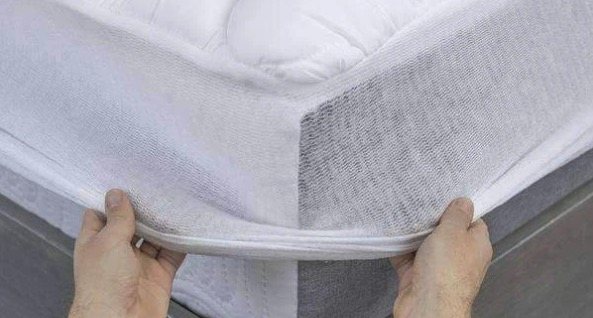
Therefore it’s important to invest in a durable encasement with a strong seal if you’re looking to contain an existing infestation.
Benefits of Mattress Encasements For Bed Bugs
Below are some key benefits to purchasing a specialized mattress encasement.
1. Helps Prevent Future infestations – When bed bugs are newly introduced to an environment, an encasement requires them to restrict movement to outside of the mattress. This prevents bed bugs from hiding in the mattress or box spring.
2. Helps Protect New Beds – After buying a new mattress because of an existing bed bug infestation, the last thing you want to do is have to replace your mattress YET again. Luckily, an encasement prevents your new mattress from getting infested.
3. Allows for Easier Inspection – Encasements eliminate the time required during an inspection and treatment of mattresses and box springs. These bugs are either trapped inside or restricted to the outside of the bed where they are more easily detected.
4. Protects From Stains – Bed bugs can damage your new mattress through blood stains or their droppings. A cover will preserve the clean color of your mattress.

We should note that not just any mattress encasement will do the job…
So it’s important to use an encasement that’s specifically manufactured for bed bug purposes.
There are several brands to choose from, some of which consist of special seams or zippers that provide a better seal.
How to Pick a Mattress Encasement?
When looking to purchase an encasement make sure to ask yourself the following questions:
Is it Tested and Backed by Science?
Bed bug covers that are sold by trusted experts undergo rigorous testing to ensure it’s a quality product. Make sure you check that the cover you choose has been lab certified and tested by experts.

Is it a Full Encasement?
Remember the difference between mattress covers and encasements?
There are covers that market themselves as “bed bug proof” but don’t actually encase the mattress and box spring.
And without proper containment…
It’s as if you had no cover at all.
Is it Free of Toxins & Chemicals?
There are covers out there that contain pesticides that assist in killing bed bugs.
These chemicals can be harsh and unhealthy, so make sure you don’t risk your safety for the sake of killing bed bugs.
Is it Sealed?
The only way this works to slow an infestation is if the cover can kill existing bed bugs by trapping them.
Bed bugs are very small, flat creatures that can fit through tiny spaces, so the cover should have a zipper with reinforced seams.
The high-quality covers can be more expensive but contain strip seals that protect the zipper and ensure a reinforced seal.
How Much do Mattress Covers Cost?
Without investing in the proper equipment to prevent or assist in the elimination of the infestation…
Things can get a lot worse.
Bad infestations can take months and $1,000s of dollars in extermination fees to remove.

Therefore the ideal way to start conquering an infestation is to utilize the mattress encasement.
(A small investment compared to the worst-case scenario).
The price of mattress covers completely depend on the quality and size of your bed:
To help cover these costs, it’s important to see whether you’re eligible for compensation for your bed bug injuries.
Below is a table highlighting the large price ranges for bed bug mattress protectors.
| Low Range | High Range | |||
|---|---|---|---|---|
| Twin Size Bed | $10.99 | $549.00 | ||
| Full Size Bed | $11.99 | $600.00 | ||
| Queen Size Bed | $15.99 | $649.00 | ||
| King Size Bed | $17.99 | $799.00 |
As you can see, less expensive mattress covers range from $11.00 – $20.00
The less expensive vinyl covers also help protect against dust mites, allergens, and bacteria.
Many of these cheaper options are in fact machine washable (and tumble dried or hung out to dry).
Expensive protective mattress and box spring covers range from $500 – $600
These higher quality covers provide protection from other problems as well.
Not only will they help against dust mites and allergens…
But they have allergy and chemical-free options that protect against pollen, mold, and pet dander.
What is the Best Mattress Cover for Bed Bugs?
It can be hard to find non-biased reviews for bed bug mattresses (especially when publishers profit off the product purchase).
Below are our three favorite mattress covers:
(non-sponsored and unbiased).
1. Premium Zippered Mattress Encasement by SafeRest
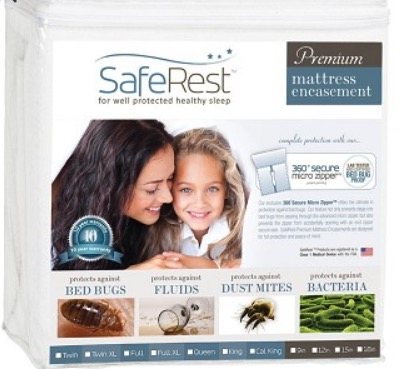
This mattress comes highly recommended due to its breathable material and specially designed zipper guard.
These covers are also completely waterproof, and machine washable. So the convenience is definitely there for these covers.
2. Linenspa Zippered Encasement
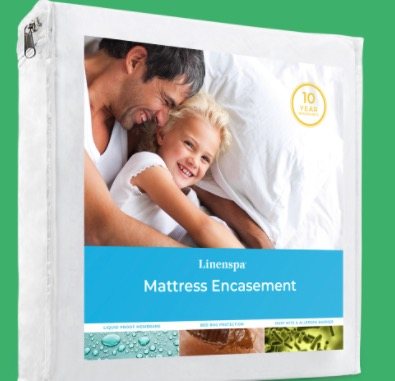
This affordable product comes in all mattress sizes, providing a total 360-degree protection for your bed.
This material is also thin and waterproof.
(and most importantly, vinyl free)
This is a go-to mattress for children because it won’t cause crinkling during the night. It’s considered one of the softest covers on the market!

This cover is ideal for deep mattresses, as it can fit any mattress that’s up to 20 inches deep.
It’s also made of a soft cotton material…
Creating a noiseless experience for those who move around in their sleep.
This cover has a 30-day money-back guarantee if it doesn’t meet your needs.
Other notable mattress covers to buy:
- Utopia Bedding Zippered Mattress Encasement – Waterproof Mattress Protector (Queen)
- Hospitality Products Sleep Defense System – Zippered Mattress Encasement – Queen – Hypoallergenic – Waterproof – Bed Bug & Dust Mite Proof
- SafeRest Premium Hypoallergenic Waterproof Zippered Certified Bed Bug Proof Box Spring Encasement (fits up to 9″)
- Home Collection Liquid and Bed Bug Proof Total Mattress Encasement
How Long Can Bed Bugs Live in a Mattress Cover?
Ideally, you would leave your bed bug mattress cover or encasement on for 14 to 18 months.
(one year at the very least)
This will ensure that all bed bugs (and their eggs) have died before you remove the encasement.
This is yet another reason why you should probably invest in a premium cover…
Because you’ll be using it for a long time.
On average bed bugs will feed once per week. Although there are situations where they can last a long time without food.
If the temperature drops for example, bed bugs can fall into a dormant state.
(Like hibernation).

If bed bugs move into this state, they can last up to a year without food.
Bed Bug Covers for Couches
Since couches usually reside in a living room or den…
(where people congregate)
There is feeding potential here for a bed bug. Even though bed bugs prefer to live around beds, the couch is not a bad second choice.
Just like mattress encasements, finding the right encasement for your couch is crucial.
If you buy a cover that’s too big…
The couch won’t be comfortable, and the cover could also come loose.
If you buy a cover that’s too small….
It could rip and allow bed bugs to escape.

When buying an encasement for your couch. You should take the following things into consideration:
Is the Couch Treated?
Although your covers will trap bed bugs effectively for 12 to 18 months, you should still have your couch chemically treated.
Treating and covering your couch is a great alternative to simply throwing it AWAY.
(Which is essentially flushing $500 to 1,000 down the toilet).
Am I getting a Good Quality Couch Cover?
There are many alternatives when it comes to quality. Some of the most helpful features in couch covers are:
- Breathability
- Fire retardant
- Waterproofing
- Hypoallergenic
Is it the Correct Size?
Measure your furniture before you make a purchase.
Get the full dimensions of your couch:
(width, length, height)

And compare it closely with the dimensions of the sofa cover.
Installing the Cover
Use these simple tricks to make the covering more effective long term:
- Place cardboard under the couch feet to prevent the cover from ripping.
- Use heavy-duty tape over the zipper to create a stronger seal.
- Keep sharp objects off the covering.
- Don’t let your pets on the covering (if they show a tendency to rip things apart).
How do I Protect My Mattress from Bed Bugs?
The first step is to cover all mattresses, box springs, and pillows with special encasements.
That will start the process of slowing down the spread of bed bugs.
Here are a few other tips to protecting your mattress:
When Traveling:
- After you get back from vacation, DO NOT put your luggage on your bed or even in your bedroom. Store your luggage in the garage, basement or bathroom.
- Do a quick inspection, checking for physical bugs as well as common signs of an infestation.
- Immediately wash and dry all items after opening your suitcase.

Treatment:
- Make sure to use proper treatment methods to remove an infestation. This could include DIY methods, or, in the case of severe infestations… You might need professional heat treatment.
- Vacuum thoroughly and avoid clutter. A messy home can make bed bugs more difficult to spot.
Overall the best treatment methods are prevention and mitigation.
The first step in ridding yourself of an infestation is proper identification and taking precautions when necessary.
It’s critical that you take swift action because once an infestation gets too severe, it can turn your life upside down.
Bed Bugs & Memory Foam
You may think that your memory foam mattress and pillows are immune to bed bug infestations…unfortunately they’re not.
Memory foam attracts bed bugs just like any other kind of mattress.
Unlike other mattresses with a spring and cotton base, memory foam mattresses won’t have visible bed bug markings on the top. This can make bed bug detection even more difficult as evidence of bed bugs can be easily hidden.
You should check the following areas in case you’re unsure if you have an infestation in your memory foam mattress or not:
1. Mattress Corners: This is the most important place to start your search for bed bugs. These creatures like burrowing into small spaces so they can efficiently protect their offspring.
So what better place than the tiny corner of a mattress between the fluff and seams?
2. Mattress Underside + Box Spring: Especially with memory foam mattresses, bed bugs can hide on the underside of your bed. Don’t worry too much if you have a regular mattress, those are so much easier for bed bugs to get into from the top.
3. Mattress Seams: The places where your bed is sewn together are breeding grounds for hungry bed bugs. They love settling in under the lip of seams and can end up spawning dozens of young from these hiding spaces.
Can Bed Bugs Live in Memory Foam Mattresses?
Bed bugs can definitely live in memory foam mattresses. Experts say that bed bugs often crawl underneath beds and climb up onto the bottom of memory foam mattresses because they find it difficult to break through the tougher surface.
Since memory foam is a lot more solid and has less breathing room than a normal mattress, you may be a little less likely to get them, albeit definitely not in the clear.
Bed bugs are resilient creatures and if there’s a way to get to your memory foam mattress, they’ll find it.
Other Ways to Eliminate an Infestation
If your infestation is to the degree that a mattress cover alone won’t contain it, consider these other DIY options to help kill bed bugs.
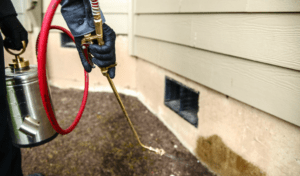
Of course, you can always get in contact with professional extermination services if you feel the infestation is getting out of control.
Like other similar insects, bed bugs are notorious for their survival instinct, so anything other than industrial grade treatments likely will not solve your problem permanently.
Takeaways
If you’re concerned about bed bugs in your mattress, you can do these checks to ensure early detection.
Check all areas of your mattress. Do not overlook any nooks or crannies that you may think are too small for bed bugs to get through.
Look for common bed bug signs. This includes bed bug droppings, that can appear on the top of a mattress and in rare occasions, on the underside of sheets.
Call in the professionals. If you’re at all concerned with the thought of bed bugs crawling around your bed, get in touch with the exterminators that know these creatures best.
Protect your memory foam mattress with a protector targeted at bed bugs. These protectors are often thicker than your normal fitted sheet and slide right underneath them.
You May Be Eligible For Financial Compensation
If you have suffered property damage or any serious injury due to a bed bug infestation, our team of bed bug experts and lawyers are here to help.
To set up a free case evaluation, get in contact with us today.
